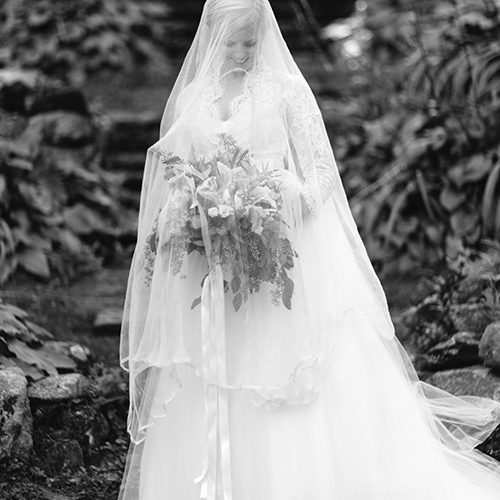
Photo: Rodeo & Co. Photography
Nothing says final touch to your wedding day look like a stunning veil! But with so many options (birdcage or cathedral length? Lace or beading?), selecting the right veil can be almost as intimidating as finding your wedding dress. Luckily, these tips, in large part thanks to Briana Abedi, senior stylist at Carine’s Bridal Atelier in Washington D.C., will help make veil shopping a piece of cake!
Pinpoint Your Budget
First things first, have a price tag in mind. What can seem to be a flimsy piece of fabric can actually cost much more than expected, easily racking up your wedding style budget. Some veils may even cost more than the actual dress itself. “Like gowns, veils can range significantly in price — usually dependent on the detailing,” says Abedi. “A simple veil can start at about $250-$300, while our more ornate veils can reach up to $3,000 or higher.” Having an idea of what you can spend will help you narrow down your veil options right away.
Complement Your Dress
Your veil will help shape your style on the big day, so naturally, you’ll want something that balances the vibes of your dress without overshadowing it. Abedi, who likes to show the bride different styles that might complement her gown, says “I like to pick several options for the bride to experiment with to embody different looks. The look can change completely just with the addition of a veil, so it’s important that the bride feels most beautiful in whatever the vision may be.”
Don’t be afraid to try something you wouldn’t normally gravitate towards. You may be surprised — keeping things matchy-matchy isn’t always the best way to complement your gown, depending on the look you want to achieve. “Sometimes, mixing textures is a great way to add some originality,” adds Abedi. “For instance, a lace-trim veil paired with a very clean gown!”
Think Hairstyle
Of course, you’ll want your veil to also go with your hairstyle. A chignon versus long flowing curls may result in a completely different veil placement. For example, if you’re wearing the former, you may want to pin your veil below the bun to show off your updo. If you’re envisioning the latter, you may want to pin the veil on the crown of your head to add volume. And if you’re hoping to add hair accessories to your look, let your bridal stylist know what you have in mind so she can help you choose the right veil style that will suit your accessories. You don’t want your head to look cluttered!
To Blusher or Not to Blusher
For those not familiar, a blusher is a short veil that covers the bride’s face; it can be by itself or attached to a back veil. Undecided if you want to rock one down the aisle? “I’m a believer that it’s best to have and not need than to need and not have!” says Abedi, who adds that even if not in use, the blusher adds a nice touch. “On the other hand, if the gown has an intriguing back, we may opt for a veil without the blusher for less coverage.”
Choose the Right Length
Abedi finds that choosing the wrong length is one of the most common mistakes she sees brides make when choosing a veil. Ideally, the length should be about 10-12 inches longer than the end of the gown’s train. “Too short, and the veil can disrupt the gown’s detail by ending mid-train,” she says. “Too long, and the veil will bunch together and ultimately drag down the aisle.” Sounds tricky, but there’s a bright side: Many veils are custom-ordered and can be made to any length.
See More: 20 Stunning Wedding Headpiece Ideas
